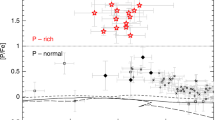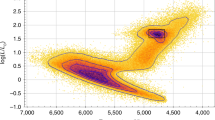Abstract
The chemically most primitive stars provide constraints on the nature of the first stellar objects that formed in the Universe; elements other than hydrogen, helium and traces of lithium present within these objects were generated by nucleosynthesis in the very first stars. The relative abundances of elements in the surviving primitive stars reflect the masses of the first stars, because the pathways of nucleosynthesis are quite sensitive to stellar masses. Several models1,2,3,4,5 have been suggested to explain the origin of the abundance pattern of the giant star HE0107–5240, which hitherto exhibited the highest deficiency of heavy elements known1,6. Here we report the discovery of HE1327–2326, a subgiant or main-sequence star with an iron abundance about a factor of two lower than that of HE0107–5240. Both stars show extreme overabundances of carbon and nitrogen with respect to iron, suggesting a similar origin of the abundance patterns. The unexpectedly low Li and high Sr abundances of HE1327–2326, however, challenge existing theoretical understanding: no model predicts the high Sr abundance or provides a Li depletion mechanism consistent with data available for the most metal-poor stars.
This is a preview of subscription content, access via your institution
Access options
Subscribe to this journal
Receive 51 print issues and online access
$199.00 per year
only $3.90 per issue
Buy this article
- Purchase on Springer Link
- Instant access to full article PDF
Prices may be subject to local taxes which are calculated during checkout


Similar content being viewed by others
References
Christlieb, N. et al. A stellar relic from the early Milky Way. Nature 419, 904–906 (2002)
Shigeyama, T., Tsujimoto, T. & Yoshii, Y. Excavation of the first stars. Astrophys. J. 568, L57–L60 (2003)
Umeda, H. & Nomoto, K. First-generation black-hole-forming supernovae and the metal abundance pattern of a very iron-poor star. Nature 422, 871–873 (2003)
Limongi, M., Chieffi, A. & Bonifacio, P. On the origin of HE 0107–5240, the most iron-deficient star presently known. Astrophys. J. 594, L123–L126 (2003)
Suda, T., Aikawa, M., Machida, M. N., Fujimoto, M. Y. & Iben, I. Jr. Is HE 0107–5240 a primordial star? The characteristics of extremely metal-poor carbon-rich stars. Astrophys. J. 611, 476–493 (2004)
Christlieb, N. et al. HE 0107–5240, a chemically ancient star. I. A detailed abundance analysis. Astrophys. J. 603, 708–728 (2004)
Wisotzki, L. et al. The Hamburg/ESO survey for bright QSOs. III. A large flux-limited sample of QSOs. Astron. Astrophys. 358, 77–87 (2000)
Noguchi, K. et al. High dispersion spectrograph (HDS) for the Subaru telescope. Publ. Astron. Soc. Jpn 54, 855–864 (2002)
Beers, T. C. & Christlieb, N. The discovery and analysis of very metal-poor stars in the galaxy. Annu. Rev. Astron. Astrophys. (in the press)
Coc, A., Vangioni-Flam, E., Descouvemont, P., Adahchour, A. & Angulo, C. Updated big bang nucleosynthesis compared with Wilkinson microwave anisotropy probe observations and the abundance of light elements. Astrophys. J. 600, 544–552 (2004)
Ryan, S. G., Norris, J. E. & Beers, T. C. The Spite lithium plateau: ultrathin but postprimordial. Astrophys. J. 523, 654–677 (1999)
Ryan, S. G., Gregory, S. G., Kolb, U., Beers, T. C. & Kajino, T. Rapid rotation of ultra-Li-depleted halo stars and their association with blue stragglers. Astrophys. J. 571, 501–511 (2002)
Pinsonneault, M. H., Walker, T. P., Steigman, G. & Narayanan, V. K. Halo star lithium depletion. Astrophys. J. 527, 180–198 (1999)
Richard, O., Michaud, G. & Richer, J. Models of metal-poor stars with gravitational settling and radiative accelerations. III. Metallicity dependence. Astrophys. J. 580, 1100–1117 (2002)
Aoki, W., Norris, J. E., Ryan, S. G., Beers, T. C. & Ando, H. Detection of lead in the carbon-rich, very metal-poor star LP 625–44: A strong constraint on s-process nucleosynthesis at low metallicity. Astrophys. J. 536, L97–L100 (2000)
Travaglio, C. et al. Galactic evolution of Sr, Y, and Zr. A multiplicity of nucleosynthetic processes. Astrophys. J. 601, 864–884 (2004)
Christlieb, N. et al. The Hamburg/ESO R-process enhanced star survey (HERES). I. Project description, and discovery of two stars with strong enhancements of neutron-capture elements. Astron. Astrophys. 428, 1027–1037 (2004)
Fryer, C. L., Woosley, S. E. & Heger, A. Pair instability supernovae, gravity waves, and gamma-ray transients. Astrophys. J. 550, 372–382 (2001)
Yoshii, Y. Metal enrichment in the atmospheres of extremely metal-deficient dwarf stars by accretion of interstellar matter. Astron. Astrophys. 97, 280–290 (1981)
Norris, J. E., Ryan, S. G., Beers, T. C. & Deliyannis, C. P. Extremely metal-poor stars. III. The Li-depleted main-sequence turnoff dwarfs. Astrophys. J. 485, 370–379 (1997)
Beers, T. C., Rossi, S., Norris, J. E., Ryan, S. G. & Shefler, T. Estimation of stellar metal abundance. II. A recalibration of the Ca II K technique, and the autocorrelation function method. Astron. J. 117, 981–1009 (1999)
Asplund, M. New light on stellar abundances analyses: departures from LTE and homogeneity. Annu. Rev. Astron. Astrophys. (in the press)
Bessell, M. S., Christlieb, N. & Gustafsson, B. On the oxygen abundance of HE 0107–5240. Astrophys. J. 612, L61–L63 (2004)
Alonso, A., Arribas, S. & Martinez-Roger, C. The empirical scale of temperatures of the low main sequence (F0V–K5V). Astron. Astrophys. 313, 873–890 (1996)
Yoshii, Y. in New Trends in Theoretical and Observational Cosmology (eds Sato, K. & Shiromizu, T.) 235–244 (Universal Academy, Tokyo, 2002)
Cutri, R. M., et al. 2MASS All-Sky Catalog of Point Sources (California Institute of Technology, Pasadena, 2003); http://irsa.ipac.caltech.edu/applications/Gator
Girard, T. M. et al. The southern proper motion program. III. A near-complete catalog to V = 17.5. Astron. J. 127, 3060–3071 (2004)
Kim, Y., Demarque, P., Yi, S. K. & Alexander, D. R. The Y2 isochrones for alpha-element enhanced mixtures. Astrophys. J. Suppl. 143, 499–511 (2002)
Kurucz, R. L. ATLAS9 Stellar Atmosphere Programs and 2 km/s Grid CD-ROM 13 (Smithsonian Astrophysical Observatory, Cambridge, 1993); http://kurucz.harvard.edu/cdroms.html
Asplund, M., Grevesse, N. & Sauval, A. J. in Cosmic Abundances As Records Of Stellar Evolution And Nucleosynthesis (eds Bash, F. N. & Barnes, T. G.) ASP Conf. Ser. (in the press); preprint at http://www.arxiv.org/astro-ph/0410214 (2004).
Acknowledgements
We thank A. Steinhauer and C. Thom for obtaining additional observations, N. Iwamoto, K. Maeda, T. Suda, N. Tominaga and H. Umeda for valuable discussions and L. Wisotzki and D. Reimers for leading the HES. This work was supported by the Astronomical Society of Australia (A.F.), Australian Research Council (M.A., A.F., J.E.N.), Ministry of Education, Culture, Sports, Science and Technology in Japan and JSPS (all Japanese co-authors), Deutsche Forschungsgemeinschaft (N.C.), Swedish Research Council (P.S.B., K.E.), US National Science Foundation (T.C.B.) and JINA (T.C.B., N.C., A.F., J.E.N.). This work is based on data collected at the Subaru Telescope, which is operated by the National Astronomical Observatory of Japan.
Author information
Authors and Affiliations
Corresponding author
Ethics declarations
Competing interests
The authors declare that they have no competing financial interests.
Rights and permissions
About this article
Cite this article
Frebel, A., Aoki, W., Christlieb, N. et al. Nucleosynthetic signatures of the first stars. Nature 434, 871–873 (2005). https://doi.org/10.1038/nature03455
Received:
Accepted:
Issue Date:
DOI: https://doi.org/10.1038/nature03455
This article is cited by
-
Progress in nuclear astrophysics of east and southeast Asia
AAPPS Bulletin (2021)
-
Abundances of neutron-capture elements in CH and carbon-enhanced metal-poor (CEMP) stars
Journal of Astrophysics and Astronomy (2020)
-
Angular momentum distribution during the collapse of primordial star-forming clouds
Astrophysics and Space Science (2016)
-
The numerical frontier of the high-redshift Universe
Computational Astrophysics and Cosmology (2015)
Comments
By submitting a comment you agree to abide by our Terms and Community Guidelines. If you find something abusive or that does not comply with our terms or guidelines please flag it as inappropriate.



